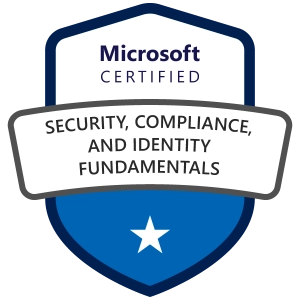Modules
Module 1: Describe security and compliance concepts
Learn about common security and compliance concepts that are foundational to Microsoft solutions. Topics include the shared responsibility and Zero Trust models, encryption, data residency and data sovereignty, and more.
Learning objectives
After completing this module, you will be able to:
- Describe the shared responsibility and the defense-in-depth security models.
- Describe the Zero-Trust model.
- Describe the concepts of encryption and hashing.
- Describe some basic compliance concepts.
Module 2 : Describe identity concepts
Learn about the key concepts of authentication and authorization and why identity is important in securing corporate resources. You’ll also learn about some identity-related services.
Learning objectives
After completing this module, you will be able to:
- Understand the difference between authentication and authorization.
- Describe the concept of identity as a security perimeter.
- Describe identity-related services.
Module 3 : Describe the function and identity types of Microsoft Entra ID
Microsoft Entra ID is Microsoft’s cloud-based identity and access management solution that connects people to their apps, devices, and data. Learn about the functions and identity types supported by Microsoft Extra ID.
Learning objectives
After completing this module, you will know how to :
- Describe the function of Microsoft Extra ID.
- Describe the types of identities Microsoft Extra ID supports.
Module 4 : Describe the authentication capabilities of Microsoft Extra ID
Learn about the authentication capabilities of Microsoft Entra ID, including multifactor authentication, and how they improve security. You’ll also learn about self-service password reset (SSPR) and the password protection and management capabilities.
Learning objectives
After completing this module, you will be able to:
- Describe the authentication methods of Entra ID.
- Describe multifactor authentication (MFA) in Entra ID.
- Describe self-service password reset (SSPR) in Entra ID.
- Describe the password protection and management capabilities of Entra ID
Module 5 : Describe access management capabilities of Microsoft Entra ID
A key function of Microsoft Entra ID is to manage access. Learn about the conditional access and how Microsoft Entra roles and role-based access control (RBAC) helps organizations manage and control access.
Learning objectives
After completing this module, learners will be able to:
- Describe Conditional Access in Microsoft Entra ID.
- Describe Microsoft Entra roles and role-based access control.
Module 6: Describe the identity protection and governance capabilities of Microsoft Extra
Learn about protecting and governing identities with Microsoft Entra ID. Learn about Permissions Management and how it enables organization to discover, remediate, and monitor permission risks across your multicloud infrastructure.
Learning objectives
In this module, you will learn how to use the Language service to :
- Describe the identity protection and governance capabilities of Microsoft Entra ID.
- Describe Privileged Identity Management.
- Describe Permissions Management.
Module 7: Describe core infrastructure security services in Azure
Learn about capabilities Azure supports to protect your network, VMs, and your data.
Learning objectives
After completing this module, you will be able to :
- Learn how Azure security capabilities can protect the network
- Learn how Azure can protect your VMs
- Learn how to keep secrets safe with Azure Key Vault
Module 8 : Describe the security management capabilities in Azure
Learn about Microsoft Defender for Cloud and the capabilities it brings together to protect your cloud through secure score, recommendations, and enhanced features that provide cloud workload protection.
Learning objectives
Upon completion of this module, the learner will be able to:
- Describe Microsoft Defender for Cloud.
- Describe how security policies and initiatives improve cloud security posture.
- Describe how the three pillars of Microsoft Defender for Cloud protect against cyber threats and vulnerabilities.
Module 9 : Describe security capabilities of Microsoft Sentinel
Learn about Microsoft Sentinel a scalable, cloud-native, security information event management (SIEM) and security orchestration automated response (SOAR) solution. In this module, you’ll also be introduced to Microsoft Security Copilot.
Learning objectives
In this module, you will learn how to :
- Describe the security concepts for SIEM and SOAR.
- Describe how Microsoft Sentinel provides threat detection and mitigation.
- Describe Microsoft Security Copilot.
Module 10 : Describe threat protection with Microsoft 365 Defender
Learn how to manage data loss prevention policies and mitigate data loss prevention policy violations.
Learning objectives
After completing this module, you’ll be able to :
- Describe the Microsoft 365 Defender service.
- Describe how Microsoft 365 Defender provides integrated protection against sophisticated attacks.
- Describe and explore Microsoft 365 Defender portal.
Module 11 : Describe Microsoft’s Service Trust portal and privacy capabilities
Microsoft runs on trust! Here you’ll explore the Service Trust Portal for content on how Microsoft delivers on our commitment of trust. You’ll also learn about Microsoft Priva, a solution to help meet privacy goals.
Learning objectives
After completing this module, you’ll be able to :
- Describe the offerings of the Service Trust Portal.
- Describe Microsoft’s Privacy principles.
- Describe Microsoft Priva.
Module 12 : Describe the compliance management capabilities in Microsoft Purview
Explore the Microsoft Purview compliance portal, the portal for organizations to manage their compliance needs. Learn about the Compliance Manager and compliance score, which can help organizations manage, simplify, and improve compliance across their organization.
Learning objectives
After completing this module, you will be able to :
- Describe the Microsoft Purview compliance portal.
- Describe Compliance Manager.
- Describe the use and benefits of compliance score.
Module 13 : Describe information protection and data lifecycle management in Microsoft Purview
Information protection and data lifecycle management in Microsoft Purview helps organizations classify, protect, and retain their data where it lives and wherever it goes. Learn about data classification capabilities, data loss prevention, and records management.
Learning objectives
After completing this module, you will be able to :
- Describe data classification capabilities
- Describe records management
- Describe data loss prevention
Module 14 : Describe insider risk capabilities in Microsoft Purview
Insider risks are a top concern for organizations. These risks can be challenging to identify and mitigate. Learn how Microsoft Purview enables organizations to identify, analyze, and remediate internal risks before they cause harm.
Learning objectives
After completing this module, you will be able to :
- Describe insider risk management
- Describe communication compliance
- Describe information barriers
Module 15 : Describe the eDiscovery and Audit capabilities in Microsoft Purview
Organizations may need to identify, collect, and/or audit information for legal, regulatory, or business reasons. Learn how the eDiscovery and audit capabilities of Microsoft Purview help organizations find relevant data quickly.
Learning objectives
After completing this module, you’ll be able to:
- Describe the eDiscovery capabilities of Microsoft Purview.
- Describe the auditing capabilities of Microsoft Purview.



Reviews
There are no reviews yet.